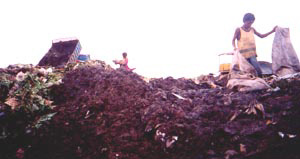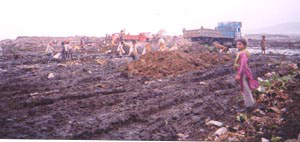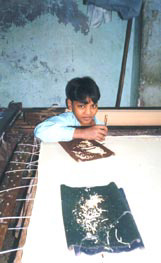News
Rag Time

An Indian American amidst the rag picking children of Mumbai.
|
They say that the summer after the first year of medical school is the last real summer vacation of your life. That seems like a lot of pressure! Should I work in a laboratory to gain research experience? Should I relax on the beach, relishing every last moment of freedom? As an Indian American with an interest in international health, I settled on a third option of my own making: working with a medical aid NGO based in Mumbai, India.
Mumbai has a population of 10 million people, of whom over half live in slums. I decided to work on a project undertaken by Niramaya Health Foundation and Pratham called Project Reach Out, which targets child laborers in Dharavi, Asia’s largest slum, and Baiganwadi, the site of Mumbai’s municipal garbage dump, which extends as far as the eye can see a short walk away from the Niramaya clinic. These so called “rag-pickers” walk barefoot through mounds of trash and sift through them looking for recyclable materials, such as plastic and metal. They earn anywhere from 50 cents to $1.50 per day, but every moment they spend on the site they risk exposure to dangerous bacterial and fungal diseases, cuts from jagged shards of metal and glass, and a variety of other injuries. I have visited India many times as a tourist, engaging in the typical NRI activities of shopping and visiting relatives in equal proportions, and I have even worked as a summer intern for three months in New Delhi. None of these experiences however, prepared me for my first visits to Mumbai’s slums. Just a short walk away from the Sion railway station, Dharavi is a sprawling settlement of two storied buildings located in Northwest Mumbai. Along the main road, small-scale industries supply the entire city with textiles and miscellaneous machine parts. Deeper into the slum, organized along a labyrinth of alleyways, live the people who supply much of the city’s low cost labor. Water, sewage, and runoff from decaying and dying facilities all mix to create a milky-white stream that flows down small canals cut down the center of these walkways. Within this residential maze are the karkhanas, hidden factories located above the street level and accessible only via steep staircases. The children working in these factories, aged 7 to 14, are sent to Mumbai by their parents in exchange for cash from the factory owners and the promise of a better life in the city. They work 12-hour days in unhygienic, poorly ventilated conditions, for daily wages as low as 12 cents (though a fully trained embroiderer can earn more than $1 daily). The lucky ones are fed relatively well, given numerous breaks and a day to themselves on Sundays. The unlucky ones are tortured when their work slows down, addicted to tobacco products that are forced upon them, and fed only one serving of rice each day. Seeing children so young working in such difficult conditions, I couldn’t help but think, “I can’t believe more people aren’t talking about the horrible situation these kids face.” Perhaps that’s why their problems have been largely ignored by the government and most development organizations. Despite my clinical experiences as an American medical student, the children’s problems shocked me. They are regularly treated for conditions such as intestinal worms, anemia, malnutrition, leprosy, and scabies, a painful skin infection caused by mites that burrow deep into the children’s skin. Though some of these diseases are also present in America, they rarely progress to the severity of the cases I saw in the clinic since most Americans have at least some minimal access to a primary healthcare facility.
This neglect was also evident in other ways. When I tried to talk to the children in the factories, their responses were universally brief and nervous, as they knew they were under the watchful eyes of the factory-owner. Even when they visited the clinic alone, I felt that they lacked the spirit I usually identify with kids their age. Perhaps that mixture of innocence and mischief had been sacrificed to allow them to survive their harrowing daily experience. This loss was always evident to me while I looked into their eyes, while I watched them drift in and out of the clinic, and while I sat helplessly wondering what could be done to make life better for them. I thought that maybe I would feel better after helping to care for at least one child, but realizing that he was leaving the clinic to return to his life in the factory took away any satisfaction I might otherwise have. Much has been said of the apathy of Indians (both in India and settled abroad) when it comes to addressing India’s incredible disparities. India has world-class private hospitals, for example, yet most people lack access to the most basic medical services. Perhaps people feel overwhelmed by the scale of the problem; over six million people in Mumbai live in slums. Perhaps they feel that the situation in the slums doesn’t really affect their daily lives. But the slums are an integral part of the city itself, affecting the labor system, manufacturing, and health profile of Mumbai. Despite the many changes India has gone through over the last decade of economic liberalization, the poor continue struggle for the most basic necessities.
The residents of Mumbai’s slums and the rural farmers who send their children to work in the garbage dumps all want the same things every parent wants. They want their kids to be healthy and to have an opportunity for a better life. They can even visit the organizations in India during their next family vacation. Ignoring the issue of poverty in India is to accept an illusion. Ending our acceptance of this illusion is the first step towards making a difference. |



